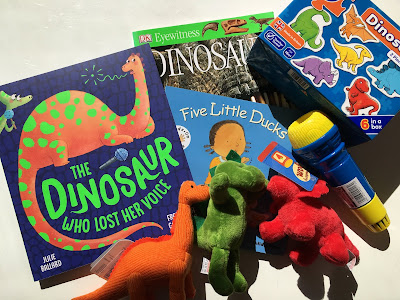I’ve been creating story sacks for a few years now, and I love it. Compiling a story sack around a particular book is sometimes easy and other times challenging, and over the years through a process of trial and error I’ve found a few things that help. So this is a post full of antidotes tips to help anyone who is interested in putting together their own story sacks.
So before we start our post, here is a quick note on what a story sack is, and what it includes…
Story Sack Checklist
- A good quality fiction book. (picture book or novel)
- A non-fiction book related to the story and themes in the chosen picture book.
- Toys, (ideally a soft toy for younger children).
- A game or activity also related to the theme of the chosen fiction book.
- Optional worksheet based on the story and themes off the story sack.
TIP 1 - Pick a Common Theme - if you are compiling you first story sack or simply if you want to have an easy time sourcing items for a story sack, base it around a story with a common theme. If you construct a story stack around a book about dinosaurs, pirates, unicorns of space, you’ll find lots of options for games, soft toys and non-fiction books, and many of which will be inexpensive or sourced second hand , keeping the cost down.
Tip 2 –Keep your Eyes Pealed - there are certain things that are the cornerstone of any story sack, plush toys that are based on the main characters and games and nonfiction books that further explore the themes in the main book it’s based around. Sometimes these themes are so popular it easy to find the items you need other times it is difficult because the characters are so unique - in that case you need to get creative, making your own or you’ll need to enlist the help of a crafty friend. Others are a challenge to source even though they shouldn’t be, like BAME plush toys. Therefore if it is good to get in the habit of keeping your eyes peeled and picking up any when you see them. For instance I brought a few plush dolls in varying genders and colours from a museum gift shop, so that I’d have them ready when I need them. It’s also good to keep an eye out for bargains in sales and charity shops for future projects to keep costs down.
Tip 3 Become a Hoarder – When you are creating Story Sacks it can make things easier if you have a stock of items ready. To that end, I hoard things. Anything that I find that may be useful; rag-dolls or plush dolls, (with safety labels), puzzles and games, non-fiction books for common themes – space, animals, castles, and even draw string bags. This way when you find a book you wish to use as the basis for a story sack you may already have some of the items to accompany it. Also if you are in a school environment, you also have spare items if any of the bits in a story sack get broken or misplaced.
TIP 4 - Have Patience - When I create story sacks for newly published books or and book by a debut writer/illustrators, I like to post the piece to coincide with the publication in order to champion the books. However when I’m creating a story sack around a classic book I find I can take my time. This means I can wait for the right items to come along at the right price rather than source the items new. This of course takes patience, and means you have to keep your eyes peeled and be a hoarder storing things until you have all the items to complete the story sack.
For instance a few years ago, I found a BNWT astronaut plush in a charity shop for 50p, when I brought it I discovered it was a MR BENN, so I decided to start collecting stuff for a story sack. Over the last few years, I found a second hand copy of the picture book story for £3, a new DVD of the animated series for £1, a still cellophane covered unopened box of the MR BENN GRAB GAME, for £2.50. Whilst looking around I found a non-fiction book about dressing up for 50p and a new box of cardboard origami dress up hats for 50p. All that was needed was a MR Benn toy in his usual suit, which eventually I found in a charity shop last week for £4.00. So eventually my patience paid off!
























